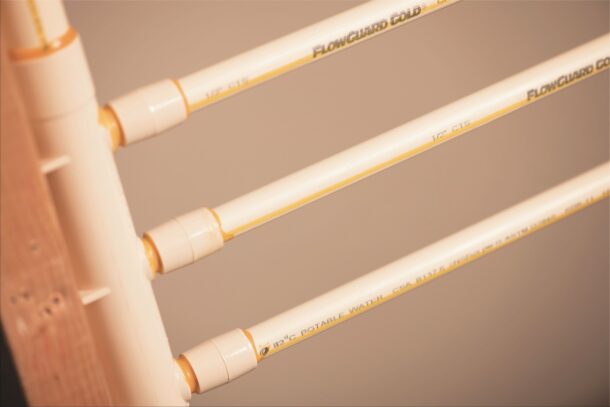By Jonathan Simon
In plumbing, like many trades, knowledge is often shared plumber-to-plumber in the field. That allows experience to get passed from one generation to the next. But sometimes the information shared doesn’t keep up with new developments or, like a childhood game of “telephone,” gets distorted over time and becomes inaccurate. The result is the proliferation of “myths” that are accepted as true by some but are provably false. Here are five myths related to CPVC plumbing systems that the FlowGuard Gold® CPVC team has encountered in the field–and the truth behind the myth.
Myth 1: CPVC should be replaced when it shows signs of discoloration
It’s easy to see how some myths get started. A plumber may think that discoloration is an indication of structural weakness, decides the pipe needs to be replaced and passes that “tip” onto a younger plumber.
But older CPVC pipes that show signs of discoloration do not need to be replaced. CPVC naturally becomes more rigid as it ages and may discolor, but these factors do not increase the risk of failure in a properly installed and serviced system. In fact, the pressure-bearing capability of CPVC pipes improves with age, so, by that measure, an older CPVC pipe is actually stronger than it was when first installed.
It is recommended that plumbers use C-style cutters, a wheel cutter, or a fine-tooth saw when servicing older CPVC pipes, but there is no reason to remove the pipe from service due to discoloration. One of CPVC’s strengths is the material’s long service life—some of the first CPVC pipes ever installed back in the 1960s are still in service today–and discoloration is not a reason to shorten that service life.

Myth 2: CPVC is difficult or slow to install
Some myths are rooted in misperceptions and false assumptions while others can be traced to competitors seeking to gain traction in a competitive market. The myth that CPVC is difficult to install falls into the second category.
CPVC plumbing systems are similar to copper in their design. Both are rigid systems that use socket-style fittings in which the pipe fits into the fitting. But CPVC is easier to work with than copper and the solvent welding process used to bond CPVC pipes and fittings is simple, easy to learn and does not require any special tools. CPVC plumbing systems install faster than copper and have installation times that compare favorably to PEX systems.
Independent research studies that measured installation times for CPVC and PEX systems found that CPVC trunk-and-branch systems install up to 17% faster than comparable PEX trunk-and-branch systems. A PEX mini-manifold system installed 10% faster than a CPVC trunk-and-branch system but used 21% more pipe and the added material costs outweighed the time savings. Most plumbers with experience using both materials have reported no noticeable speed difference between CPVC and PEX plumbing systems.
Myth 3: CPVC can’t handle higher pressures and temperatures
A review of material specifications will quickly dispel this myth. Plumbing codes require that domestic water plumbing systems be capable of handling at least 100 psi of pressure at 180°F without ballooning or bursting. FlowGuard Gold pipes and fittings not only meet this requirement but are pressure rated to 400 psi at room temperature and above 200 psi at all temperatures up to 140°F. When subjected to extreme quick-burst testing, a solvent-welded FlowGuard Gold CPVC plumbing system will not typically fail until the system reaches pressures of 1200 psi or higher.
In addition, CPVC isn’t subject to additional temperature and pressure limitations imposed by chlorinated water on other plastic plumbing systems (140° F and 80 psi). That makes CPVC ideal for higher temperature applications such as hot water lines. It can even support legionella mitigation strategies that store water above 140°F. In multi-story buildings, CPVC’s excellent pressure rating enables use of gravity-fed distribution systems and booster pumps that can introduce risks to other plastic plumbing systems.
Myth 4 CPVC is not as sustainable as other plumbing systems
You might expect a plastic piping system like CPVC to be less sustainable than a metal system like copper, but CPVC has excellent sustainability credentials.
FlowGuard Gold CPVC requires less energy to manufacture and produces fewer greenhouse gases over its service life than PEX and copper systems. The material’s long service life, enabled by its chlorine immunity, means less material is ultimately required to support the application. Plus, CPVC is recyclable through proper centers.
FlowGuard Gold CPVC is also the only residential plumbing system certified by Home Innovation Labs National Green Building Standard (NGBS) and has a lifecycle assessment to contribute to LEED certification.
Myth 5: CPVC is more expensive than other plastic plumbing systems
Plumbers who haven’t compared material costs can be forgiven for believing CPVC is one of the more expensive plumbing systems. After all, FlowGuard Gold CPVC is the only material in the industry that offers a warranty that isn’t voided by exposure to chlorinated water, putting it in a class by itself. It doesn’t make sense that it should be less expensive, but it is. According to a cost study done by a leading PEX manufacturer, CPVC material costs were half the cost of their own PEX system.
These savings come from two key areas: fittings and pipe sizing. While a PEX system contains about 30% fewer fittings than a CPVC system, those fittings (and the crimp, cinch or expansion rings that go with them) typically cost 3-5 times more than the comparable CPVC fitting. In addition, because those insert fittings introduce significant pressure drop at ½” diameters, PEX systems are typically upsized to use more 1” and ¾” pipe than required with a CPVC system, saving even more money. You can verify this yourself by comparing PEX and CPVC costs on your next job.
Better Information Leads to Better Service
Plumbers looking to deliver the best service to their customers and grow their business should be careful not to take everything they hear at face value. There are resources available that provide reliable information about plumbing systems, including manufacturer websites. To get more information on CPVC, visit the plumber’s resource center on the FlowGuard Gold website.




Join the conversation: